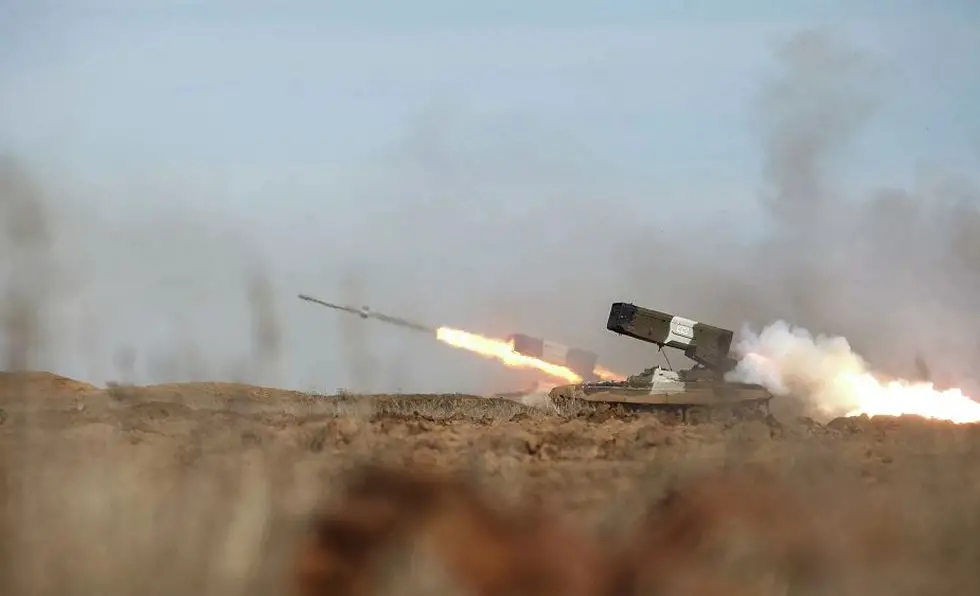Breaking news
More heavy flamethrower units to appear in Russian armies.
TOS-1A Heavy flamethrower units will appear in combined arms armies. One salvo can destroy hardware, troops and adversary fortifications on a space of four square kilometers. Experts believe the successful engagement experience in Syria made the weapons popular in the troops. Earlier it was believed than one battery of such vehicles was sufficient for the Russian armed forces, the Izvestia daily writes.

TOS-1 units have already been successfully operated in Syria against ISIL (Picture source: Russian MoD)
The Defense Ministry told the newspaper each military district will get a battalion of nine TOS-1A while an army will have a company of three combat vehicles. The troops will receive a total of over 70 flamethrowers. Battalions will appear within nuclear, chemical and biological protection (NCB) brigades, while companies will reinforce chemical regiments. The armed forces currently have five NCB brigades and ten regiments.
The first TOS-1A company set was delivered in early 2018 to the 10th separate NCB regiment of the 41st combined arms army of the Central Military District. It is deployed in Altai region. The heavy flamethrowers will be engaged as fire support vehicles for attacking forces. TOS units received tank names instead of artillery ones: batteries and squadrons are now called companies and battalions. Moving with the troops TOS-1A can destroy with precision strikes adversary fortifications and armor.
TOS-1 (Russian: тяжёлая огнемётная система (ТОС-1), Heavy Flamethrower System) is a 220mm 30-barrel (original system, Ob.634 or TOS-1M) or 24-barrel (Ob.634B or TOS-1A) multiple rocket launcher and thermobaric weapon mounted on a T-72 tank chassis. TOS-1 was designed for defeating enemy personnel in fortifications, in open country, and in lightly armoured vehicles and transport. First combat tests took place in 1988–1989 in the Panshir Valley during the Soviet war in Afghanistan. The TOS-1 was shown for the first time in public in 1999 in Omsk.
TOS-1 is not assigned to the artillery units of the Russian armed forces but is found in Russian CBRN defense units RKhBZ (Russian: войскa радиационной, химической и биологической защиты (войска РХБЗ), Radiological, Chemical and Biological Defence Troops). That is why it does not have a GRAU index, but rather an RKhBZ index — МO.1.01.00.
The crew comprises three men. The flamethrower system comprises a combat vehicle and two transloaders. The fire control system comprises a modern computer, a laser ranger, optical devices operating also in the infrared band.
The main TOS-1A weapons are thermobaric missiles. The explosive substance mixes with the air at the ground surface and inflames. The fuel and air explosion makes a firestorm spread across the terrain and penetrate shelters. The main destruction factors are high temperature and the shock wave. The pressure rapidly rises after detonation and then rapidly falls. Unguided thermobaric 200mm jet projectiles have a range of six km and the upgraded ones - 10 km. A full package salvo covers a territory of 4 km².
TOS-1A was designed on the basis of TOS-1 which fought in Afghanistan. The Soviet army fired thermobaric projectiles from heavy flamethrowers to destroy mujahedeen in caves and dugouts. Expert Alexey Khlopotov said TOS-1A demonstrated high effectiveness in Syria. A TOS-1A unit was deployed in Syria: it was used near Palmyra to destroy ISIL units outside residential areas, the Izvestia said. Previously the Russian military disagreed on the tactic of its engagement. It was believed a major number of flamethrowers was not necessary to fight terrorists. One or two would be sufficient. Due to the operation in Syria it was decided to reinforce the troops with the flamethrowers. "It is an effective attack weapon to destroy fortifications in the mountains or residential areas. You cannot hide from it in trenches or dugouts. The power of thermobaric mixture explosion makes it impossible to survive in the affected zone. The engagement of Solntsepek saved the lives of Russian soldiers assaulting fortified enemy strongholds," he said.


























